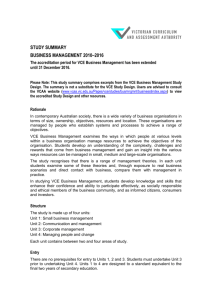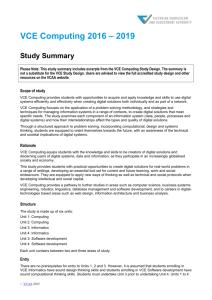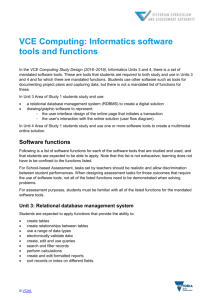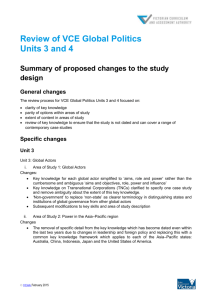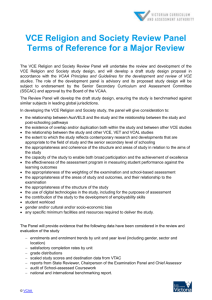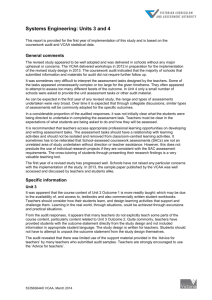VCE Information Technology - Summary of Proposed Changes to
advertisement
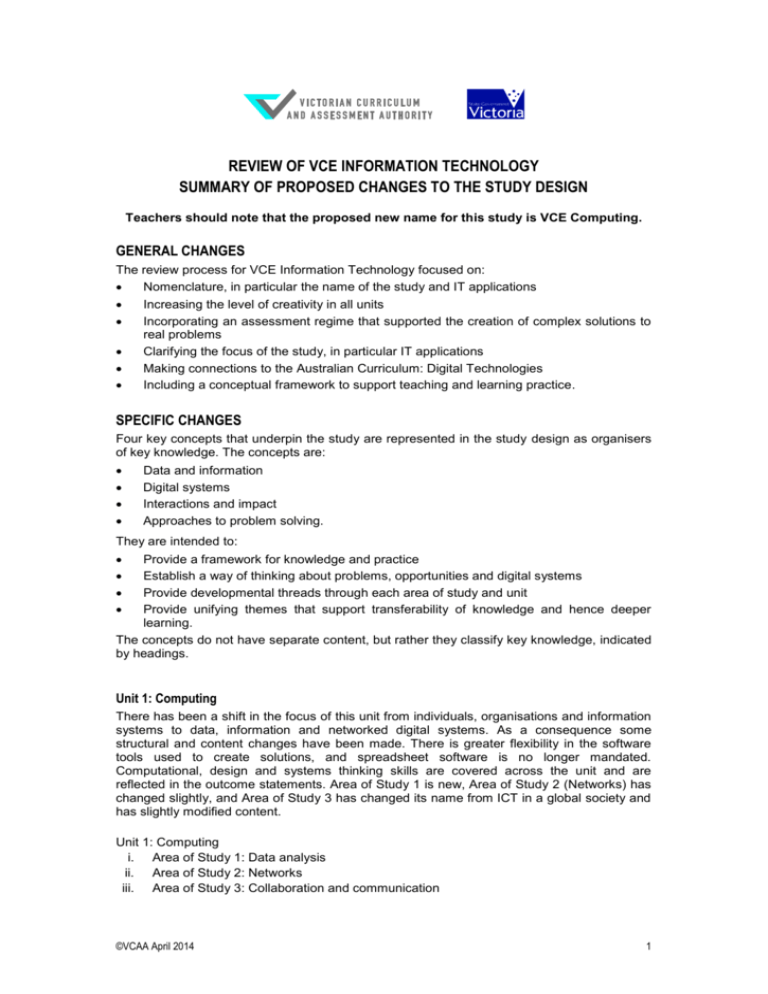
REVIEW OF VCE INFORMATION TECHNOLOGY SUMMARY OF PROPOSED CHANGES TO THE STUDY DESIGN Teachers should note that the proposed new name for this study is VCE Computing. GENERAL CHANGES The review process for VCE Information Technology focused on: Nomenclature, in particular the name of the study and IT applications Increasing the level of creativity in all units Incorporating an assessment regime that supported the creation of complex solutions to real problems Clarifying the focus of the study, in particular IT applications Making connections to the Australian Curriculum: Digital Technologies Including a conceptual framework to support teaching and learning practice. SPECIFIC CHANGES Four key concepts that underpin the study are represented in the study design as organisers of key knowledge. The concepts are: Data and information Digital systems Interactions and impact Approaches to problem solving. They are intended to: Provide a framework for knowledge and practice Establish a way of thinking about problems, opportunities and digital systems Provide developmental threads through each area of study and unit Provide unifying themes that support transferability of knowledge and hence deeper learning. The concepts do not have separate content, but rather they classify key knowledge, indicated by headings. Unit 1: Computing There has been a shift in the focus of this unit from individuals, organisations and information systems to data, information and networked digital systems. As a consequence some structural and content changes have been made. There is greater flexibility in the software tools used to create solutions, and spreadsheet software is no longer mandated. Computational, design and systems thinking skills are covered across the unit and are reflected in the outcome statements. Area of Study 1 is new, Area of Study 2 (Networks) has changed slightly, and Area of Study 3 has changed its name from ICT in a global society and has slightly modified content. Unit 1: Computing i. Area of Study 1: Data analysis ii. Area of Study 2: Networks iii. Area of Study 3: Collaboration and communication ©VCAA April 2014 1 VCE INFORMATION TECHNOLOGY SUMMARY OF PROPOSED CHANGES Unit 2: Computing Conceptually there has been a slight shift with a stronger focus on the creation of solutions that automate the processing of data through the use of programming or scripting languages and flat file database management systems software. Two areas of study are similar to the current study with one being replaced, (Tools, techniques and procedures). The new area of study is Data management that requires students to determine their own need or opportunity, collect relevant data and engage in all stages of the problem-solving methodology to create a solution using a flat database management system. Unit 2: Computing i. Area of Study 1: Programming ii. Area of Study 2: Data analysis and visualisation iii. Area of Study 3: Data management Unit 3: Informatics Significant changes have been proposed for Informatics (new name to replace IT applications), stemming primarily from the incorporation of a School-assessed Task (SAT). Two areas of study comprise the School-assessed Task; Unit 3, Area of Study 2 and Unit 4, Area of Study 1. The SAT allows students to create real-world digital solutions through project work over an extended period of time. The conditions of a SAT allow students to be assessed on process as well as product, and it allows students to create meaningful and complex digital solutions. There are no restrictions on the software tool/s used for the SAT. In Unit 3, Area of Study 2 student frame a hypothesis, and identify, collect and organise data in readiness for interpretation in Unit 4. The also create a project management plan for the SAT. The title of the units has changed and the existing area of study: Online communities has been replaced with the Organisations and data management, which is the current Area of Study 2, with some modifications. One of the assessment tasks for this outcome requires students to trace the interactions that a user has when engaging in an online transaction. Students must acknowledge the multiple entry points to a website and identify the sequence of web pages that must be visited to commence and conclude a transaction. User flow diagrams document the user’s journey. Unit 3: Informatics i. Area of Study 1: Organisations and data management ii. Area of Study 2: Data analytics Unit 4: Informatics In Unit 4, students continue working on their project that forms the SAT. They extract meaning from the data prepared in Unit 3 and formulate a conclusion to their hypothesis. Students design, develop and evaluate a solution that communicates their conclusion. They use their project plan to monitor progress, and evaluate its success in coordinating time, resources and tasks. Minor changes have been made to Area of Study 2: Information management, primarily to reduce scope. The outcome statement is slightly reworded and students only consider information management strategies for the storage and disposal of data and information. Unit 4: Informatics i. Area of Study 1: Implementing project plans ii. Area of Study 2: Information management ©VCAA April 2014 2 VCE INFORMATION TECHNOLOGY SUMMARY OF PROPOSED CHANGES Unit 3: Software development The name of this Unit 3–4 study is unchanged. The programming language used in both units does not have to be selected from a list approved by the VCAA, hence there is greater flexibility at the school level. As is the current situation, the VCAA will continue to publish a list of programming language capabilities. The introduction of a School-assessed Task (SAT) has resulted in content and structural changes in this unit. Two areas of study comprise the School-assessed Task (SAT); Unit 3, Area of Study 2 and Unit 4, Area of Study 1. The SAT allows students to create real-world digital solutions through project work. The conditions of a SAT allow students to be assessed on process as well as product, and it allows students to create meaningful and complex digital solutions. In Unit 3, Area of Study 2 students identify a problem, need or opportunity and engage in the problem-solving methodology stages of analysis and design. They also prepare a project management plan for the complete SAT using dedicated software. Area of Study 1: Programming practice replaces the current Analysing information problems, with the analysis work now being located in Area of Study 2. Area of Study 1 is similar to the current Area of Study 2, with the focus on students developing knowledge and skills in using a programming language for the purpose of creating working modules. Unit 3: Software development i. Area of Study 1: Programming practice ii. Area of Study 2: Software architecture Unit 4: Software development In Unit 4, students continue working on their project that forms the SAT. They develop their preferred design specifications and evaluate the efficiency and effectiveness of the solution and the effectiveness of their project plan as a mechanism for managing projects. During the development stage they create user documentation for a segment of the solution and conduct authenticate usability tests, incorporating feedback into their solution. Area of Study 2: Interactions and impact is new. Its focus is on data ownership and security, and ethical responsibilities and legal obligations, viewed from a systems perspective through the lens of personal data. Unit 4: Software development i. Area of Study 1: Software solutions ii. Area of Study 2: Interactions and impact ©VCAA April 2014 3 VCE INFORMATION TECHNOLOGY SUMMARY OF PROPOSED CHANGES Assessment Outcome statements in all areas of study across Units 1 to 4 have been altered to reflect the focus of the unit. Units 1 and 2 Outcome statements Current Study Outcome Statements Consultation Draft Outcome Statements Unit 1 Area of Study 1 Select data from data sets, design solutions and use a range of spreadsheet functions to develop solutions that meet specific purposes. Unit 1 Area of Study 1 Acquire, secure and interpret data, and design and develop a solution that supports or refutes a hypothesis. Area of Study 2 Recommend a networked information system for a specific us and explain possible security threats to this networked information system. Area of Study 3 Contribute collaboratively to the design and development of a website that presents an analysis of a contemporary ICT issue and substantiates the team’s point of view. Area of Study 2 Design a network solution with wireless capability, explain its configuration and predict outcomes for intended users. Area of Study 3 Contribute to the design and development of a website that presents an analysis of a contemporary issue, including a team’s point of view. Current Study Outcome Statements Consultation Draft Outcome Statements Unit 2 Area of Study 1 Apply the problem-solving methodology and use appropriate software tools to create data visualisations that meet users’ needs. Unit 2 Area of Study 1 Design, and develop working modules using a programming or scripting language. Area of Study 2 Apply the problem-solving methodology and use appropriate software tools to create dynamic data visualisations that meet users’ needs. Area of Study 2 Design, and develop using a programming or scripting language, limited solutions, record the learning process electronically, and explain possible career pathways that require the use of programming or scripting skills. Area of Study 3 Work collaboratively and apply the problemsolving methodology to create an ICT solutions, taking into account client feedback. ©VCAA April 2014 Area of Study 3 Apply the problem-solving methodology to create a solution using flat file database management software and predict the impact of its implementation. 4 VCE INFORMATION TECHNOLOGY SUMMARY OF PROPOSED CHANGES Units 3 and 4 Outcome Statements: IT applications/Informatics Current Study Outcome Statements (IT applications) Consultation Draft Outcome Statements (Informatics) Unit 3 Outcome 1 Apply stages of the problem-solving methodology to create a prototype website that meets an online community’s needs, and explain the technical requirements to support the hosting of the website. * Unit 3 Outcome 1 Design, and develop a solution using a relational database management system, and diagrammatically represent how users interact with a website when supplying data for a transaction. Unit 3 Outcome 2 Design, and develop using a relational database management system, a solution to an information problem, and discuss why and how data is acquired via websites. + Unit 3 Outcome 2 Use digital systems ethically and efficiently to acquire, structure and prepare complex data to substantiate a hypothesis, and formulate a project plan for managing progress. Unit 4 Outcome 1 Use selected software to solve an ongoing information problem, and evaluate the efficiency and effectiveness of the solution in meeting the information needs of an organisation. + Unit 4 Outcome 1 Design, develop and evaluate a solution that substantiates or refutes a hypothesis, and evaluate the effectiveness of a project plan in managing progress. Unit 4 Outcome 2 Evaluate the effectiveness of strategies used by organisations to manage the storage, communication and disposal of data and information, and recommend improvements to current practices. * Unit 4 Outcome 2 Evaluate the effectiveness of information management strategies used by organisations to manage the storage and disposal of data and information, and recommend improvements to current practices. Marks allocated 90 10 Assessment tasks In response to a design brief that includes an analysis of a need or opportunity and a data set: the design and development of a relational database management system solution. AND In response to a design brief that includes a description of the online transaction requirements of an organisation diagrammatic representation of user interfaces and interactions with a website when conducting a transaction. In response to a student-generated hypothesis: a hypothesis statement fully-referenced data sets acknowledging intellectual property digital data sets acquired by students that have been prepared for the development of a solution in Unit 4 AND a project plan (Gantt and PERT charts) indicating times, resources and tasks. A folio of 2–3 alternative design ideas and the detailed design specifications of the preferred design AND A solution that communicates the substantiation or refutation of a hypothesis as detailed in Unit 3 AND an evaluation of the effectiveness of the solution and the extent to which the project plan (Gantt and PERT charts) assisted in monitoring project progress in one of the following: a written report an annotated visual plan. 100 One of the following: a written report an annotated visual report * School-assessed Coursework for Unit 3 contributes 10 per cent. * School-assessed Coursework for Unit 4 contributes 10 per cent + School-assessed Task for Units 3 and 4 contributes 30 per cent ©VCAA April 2014 5 VCE INFORMATION TECHNOLOGY SUMMARY OF PROPOSED CHANGES Units 3 and 4 Outcome Statements: Software development Current Study Outcome Statements Consultation Draft Outcome Statements Marks allocated Unit 3 Outcome 1 Analyse an information problem in order to produce software requirements specifications for a solution that operates within a networked environment. * Unit 3 Outcome 1 Interpret design specifications and apply a range of functions and techniques using a programming language to develop working modules. Unit 3 Outcome 2 Represent a software design and apply a range of functions and techniques using a programming language to develop a prototype solution to meet a specific need. + Unit 3 Outcome 2 Decompose a need or opportunity, in order to define the solution requirements, represent the preferred design specifications, and formulate a project plan using digital systems. An analysis that defines the requirements, constraints and scope of a solution in one of the following: a written report an annotated visual report AND a folio of 2–3 alternative design ideas, and the detailed design specifications of the preferred design AND a project plan (Gantt and PERT charts) indicating times, resources and tasks. Unit 4 Outcome 1 Apply stages of the problem-solving methodology to produce a solution for use on a mobile device, which takes into account technical and legal requirements. + Unit 4 Outcome 1 Apply stages of the problem-solving methodology to create a solution using a programming language that fulfils identified requirements and evaluate the effectiveness of the project plan in managing progress. A solution that meets the software requirements specifications determined in Unit 3, including usability test and user documentation AND an evaluation of the extent to which the project plan (Gantt and PERT charts) assisted in monitoring project progress in one of the following: a written report an annotated visual plan Unit 4 Outcome 2 Evaluate the effectiveness of strategies used by organisations to manage the storage, communication and disposal of data and information, and recommend improvements to current practices. * Unit 4 Outcome 2 Discuss how the interactions between individuals and information systems result in both intended and unintended outcomes for individuals, organisations and society. Assessment tasks 100 In response to teacher-provided design specifications, create working modules to meet specific needs. 100 One of the following: a written report an annotated visual report * School-assessed Coursework for Unit 3 contributes 10 per cent. * School-assessed Coursework for Unit 4 contributes 10 per cent + School-assessed Task for Units 3 and 4 contributes 30 per cent ©VCAA April 2014 6

